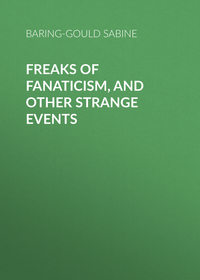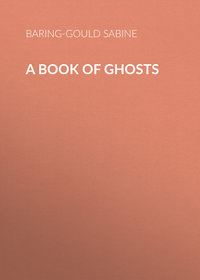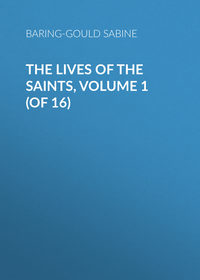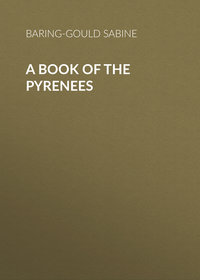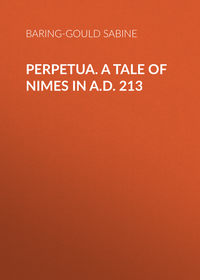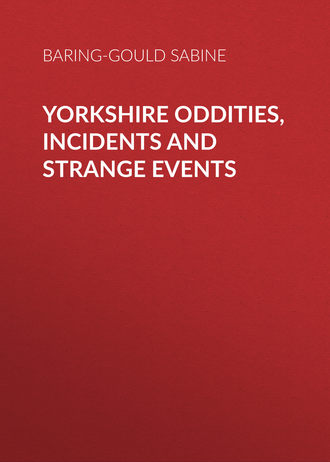 полная версия
полная версияYorkshire Oddities, Incidents and Strange Events
"If it were a shadow thrown upon the glass of the window it would, of course, be seen by those who sit in the body of the church as well as those in the gallery.
"It cannot be a reflection on the principle of Pepper's Ghost, which is produced by the figure actually being in a very strong light and appearing reflected on glass in a darkish spot. The lights both inside and outside of the church at York which might be thought to produce the ghost, are precisely the reverse, and any figure required to be reproduced by reflection on the east window would have to be standing or walking in the centre of the aisle.
"For the above facts I can vouch, and I have no reason to believe that the following are either incorrect or exaggerated.
"It is said to appear very frequently on Trinity Sunday, and to bring two other figures on to the scene, another female, called the nurse, and the child. It is often seen as distinctly on a dark, rainy, or snowy day, as when the sun is shining. When I saw it the sun was not bright.
"The motion is even, not at all jerky. Sometimes it glides swiftly; at other times slowly. It cannot be a mere accidental reflection, from a door or window, for instance, for the figure faces different ways, according to the direction in which it is going; and it is not always alone, nor do the figures always act in concert.
"One of my friends, with a companion, has watched outside on the wall, where he had a full view of the whole place around, during morning service. The ghost has been seen from the inside while outside nothing was visible.
"It is said to have haunted the church for 150, 200, and some authorities say 300 years, and there are many pretty legends connected with it.
"One of the many traditions says that 300 years ago, during religious disturbances, a party of soldiers came to sack the convent attached to this church; that the abbess, a woman of great virtue and courage, stopped them, as they were entering, declaring that they should enter over her dead body only, and that, should they succeed in their sacrilegious purpose, as they afterwards did, her spirit would haunt the place until the true Church were re-established, and a convent built on the same spot. Another story relates that during the plague, some two hundred years ago, a nurse and child died of the pestilence, and were necessarily buried outside the city walls, while the unfortunate mother of the child, at her death, was interred in Holy Trinity Churchyard. Here the mother waits and receives the nurse and child, weeping and wringing her hands before parting with them. The same scene is often enacted several times during the same day, and even during the same service.
"Whatever may have been the circumstances under which the ghost (if it is one, which it is hard to believe in these matter-of-fact days) commenced its peculiar promenade, I would recommend those who have the chance to go to Holy Trinity Church, York, and see for themselves, though an audience of the apparition cannot always be assured. A ghost in broad daylight does no harm, frightens no one, and ought to interest everybody. – I am, &c.,
"H. G. F. T."Finally the Rector of Holy Trinity, York, intervened; he wrote to the "York Herald": —
"I think the time has come when it is perhaps necessary for me to give a word of explanation in regard to this imaginary apparition. The fact is simply this: Any one seated in the gallery of the church which is at the west end, can see through the east window any person, or persons, walking in the vicarage garden. The wall at the east end of the church, below the east window, is too high to allow anyone in the body of the church to see either the garden or anyone in it. This fact explains at once the reason, how it is absolutely necessary for anyone to be in the gallery in order to see the 'ghost.' This is the real truth of the matter. What is seen is not a 'ghost;' it is not a 'reflection,' but it is a living being, or beings, walking in a garden. Of course the east window being of stained glass and of a rather peculiar pattern, a distinct form is not always visible. And I may say that this simple explanation has been attested and verified over and over again both by myself and others. One argument of proof is all, I think, that I need give. The Vicarage House was at one time empty for about 12 months, during which time the 'ghost' was neither seen nor heard of, and then it was let to a person with a large family; and on the very first Sunday after the family took possession of the premises, I was told by a simple-minded youth that the ghost had returned, and five or six young ghosts with it. After what I have here stated, I need hardly say that all the sensational matter in regard to vivid lights, mother, nurse, and child, extraordinary displays on Trinity Sunday, &c., &c., is as pure an invention as ever was fabricated by a morbid imagination. And I will add that I sincerely hope that the people of York will not take the advice of one of your voluminous correspondents, and will not go to the church for the mere purpose of seeing this purely imaginative ghost. I trust that all who go will remember it is God's house, intended to be a house of prayer, and not a place for gratifying an idle curiosity."
This letter called forth a sharp animadversion from another correspondent who signed himself "Novocastrensis," to which H. G. F. T. replied: – "I have read Mr. Gould's accounts since I saw the 'ghost,' and find that though they differ considerably in the details from my description, in the essential points they agree with and corroborate it. I should like to state here distinctly that the story was not adapted for my 'own' or any other's 'purpose' from 'Yorkshire Oddities,' but is an unprejudiced, and to the best of my belief, an unexaggerated and true account and description of what I myself saw. It is not my desire to raise a discussion, but the injustice implied in the letter is the excuse I urge for thus trespassing upon your space. – I am, &c.
"H. G. F. T."Newcastle-upon-Tyne, 6th May, 1876."This provoked another letter from a fresh correspondent: – "Sir, – I was in York when the letters appeared in the Chronicle and the Journal about the ghost in Holy Trinity Church. A lady, a member of the congregation, who has frequently seen the ghost, gave me the following simple explanation. Opposite the window there is a cottage, in one of the windows of which there is a swing pane of glass. The tenant of the cottage can cause the ghost to appear and disappear at pleasure by simply opening and shutting it, thus causing reflected sunlight to fall on the church window: – I am, &c.,
"J. L."May 9th, 1876."Another correspondent rushed into print: – "Sir, – though I am not one of those who can boast of having seen the York ghost, yet even to me the explanation published in today's Journal, in a letter signed 'J. L.,' seems utterly inadequate to explain the matter. The fact of a swing window opening and shutting might throw sunlight upon the church window, but it is perfectly clear that in such a case the reflection would not be confined perpetually to the same identical part of the window, the angles caused by the sun and the swing window being of course varied, according to the time of day. It strikes me that by those means the figures could not be reversed on their return as is always the case, according to the story. Again, the apparition is often seen in dull weather, when no sunbeam could be reflected. If the light were actually turned on to the stained glass, the congregation seated in the body of the church would be able to see it as well as those in the gallery, but they do not. I should like to see the matter explained. Yet a reason such as 'J. L.' gives for it is altogether unsatisfactory, and may be taken for what it is worth, which is not much, considering the evidence against him, and the fact that his information is only second-hand. – I am, &c.,
"R. H. H."Newcastle-on-Tyne."VI"M – Rectory, York,"Aug. 11th, 1875."Dear Sir, – Having had the pleasure of reading your interesting book 'Yorkshire Oddities,' I recognised an old acquaintance in the 'Trinity Ghost.' Happening to have found out an apparent explanation of the ghost, I thought you would be interested in hearing what I know about it.
"In 1869 I went to school at Mr. Metcalfe's, the present incumbent of the church. For my first year I saw and heard nothing about the ghost. We used to sit in two pews in the body of the church under the gallery. In 1870 we changed to a pew in the front of the gallery and the one behind it. Soon after we changed our seats, some of us saw the ghost, and the next Sunday we looked for it, and most of us saw it. The attempt was made known to find out what the ghost was. In 1871 my curiosity being rather excited by the frequent appearances of the ghost, I and a boy of the name of Yewdall determined to find out what it was. The appearance of the ghost was, as one of your informants describes it, that of a figure in a surplice, and it always went across the window from left to right, and returned from right to left. The east window is a pattern window of a good deal of red and blue glass, and beyond the window there is a small strip of churchyard and then a wall. Beyond the wall is the yard of the old parsonage house. On the left hand side of this yard is the parsonage which is rented to a few poor families who used to take in lodgers. On the other side are the offices.
"As we used to teach at the Sunday School which was held in a large room jutting out from the parsonage towards the church, we often noticed the women and children of the house going across the yard to the ashpits; and it struck us that this might be the ghost. So we went into the church directly the doors were opened and went up into the gallery while another of us walked across the churchyard in front of the east window. Curiously enough, at the same time we saw him going across the window near the bottom, the ghost went across higher up. This goes a good way to proving my supposition, as is drawn in the following diagram.
"I have forgotten to state that the ghost was always seen best in sunny weather, but it is also to be seen in cloudy weather as well as bright sunshine. Usually one ghost appeared, but I have often seen two, and a few times as many as eight children with the two big ones. This was, I suppose, the husband and wife of one of the families surrounded by the children. In 1862 (I believe the date is correct) Mr. Saul was the Incumbent, but upon his death, on vacation of the living, the parsonage house was uninhabited. During this time I have been told that the church was delivered from the ghost, but the very first Sunday the new rector came the ghosts reappeared as before. – I remain, yours truly,
– "The name I have not given, though the letter was signed.
PETER PRIESTLY, THE WAKEFIELD PARISH CLERK
In the middle of last century there lived in Wakefield a certain Peter Priestly, who for many years was sexton of the parish church of All Saints. The then vicar was Michael Bacon, D.D., a tall, portly man, of a commanding presence, who wore a large bushy wig, as was the wont of many old divines of that date. He was a man of rather a warm temperament, and was apt at times, when matters did not flow quite according to his will, to grow a little irritable, and whilst in that condition his habit was frequently to thrust his right hand in a testy, impetuous way under his wig. This habit destroyed the symmetry of that capital ornament, and made it protrude considerably on the right side; and this protrusion grew greater the longer the wig was worn.
The vicar's wigs were inherited and worn by the sexton, whose venerable and awe-inspiring appearance was much enhanced thereby. Mrs. Priestly in vain endeavoured to reduce the protuberance of hair on the right side, so as not to betray the origin of the wig. The horse-hair resumed its elasticity in spite of her efforts, and the congregation in the parish church were amused to see the stately Doctor in his reading-desk with a deformed wig, and below him the scarcely less stately clerk in a wig the counterpart of that of the Doctor. But what amused the wags not a little was to observe the fact that when the Doctor's wig was perfectly symmetrical, instantly the sexton's assumed the most exaggerated inequality in the sides. The secret, of course, was that the Doctor had donned a new wig, and had given his old one to the clerk. But after a while the irascible vicar had succeeded in brushing out the tufts of his false head of hair on the right, and simultaneously the continued efforts of Mrs. Priestly had reduced the right-hand protuberance in the wig of her husband. Consequently, as one bush grew, the other shrank into itself. But there were points – like the equinoxes – when both wigs were alike.
Now it fell out that Doctor Bacon had determined to present himself with a new wig one Easter, and he had accordingly given Peter Priestly his old wig, which had arrived at its maximum of extension on the right-hand side.
Peter had heard it said that on S. Mark's Eve the spirits of all those who are to die during the year may be seen in the church. Half believing this popular superstition and half in doubt about the truth of it, and thinking, moreover, that if it might be so, he should like to know whether trade would be brisk for him during the rest of the year, he decided that anyhow he would go to the church and see what would happen; and not wishing to spend his time idly, he determined to occupy himself with lettering some grave-stones which he had not completed. The place in which he carried on this work was the base of the church tower, which was shut off from the nave by a large boarded partition, against which stood the west gallery of the church. The opening from the tower into the nave consisted of large folding-doors.
Now, according to the story, on S. Mark's Eve a train of all those who are to die before the ensuing S. Mark's Eve come into the church through one of the doors in their winding-sheets, each carrying a corpse-candle. A ghostly priest precedes the weird procession, and dolefully intones the burial service.
When Peter had finished his supper on that eventful evening, he said to his wife: "I think, lass, I'll go and do a bit o' my lettering; so gi'e me my lantern wi' a can'le in it. I happen shan't be so varry long; but I think I'll just go for a bit. Howsomever, if I should stop a middling while, ye needn't be flayed (frightened), for I want to finish them two stoanes."
It was not without some trepidation that Peter took up his place in the tower, and left the folding-doors ajar that he might look into the nave and see the awful train sweep in.
Peter was not a nervous man, or at least he did not think himself so, and he began his work, whistling a psalm tune. He was engaged on a large grave-stone on which he had already completed about half the inscription. It was standing raised upon tressels to the required height; and at this he worked diligently for a long while, with his face towards the east and the folding-doors, and every now and then he stole to the doors and peeped through into the nave. All was perfectly dark and silent. He returned to his work with lighter heart after each glance into the great dark church. He had taken the candle out of his lantern, and had put it into an old rusty candlestick, which he kept there for the purpose, in order that he might have a better light.
The church clock, with many premonitory groanings, had struck the hours of ten and eleven, and Peter still pursued his work. The eventful ghostly hour was approaching when the graves reveal their secrets. As this hour drew nigh Peter's courage began to fail. It flashed across his mind that perhaps the spectral procession would enter the church, not through the south porch, as he had at first conjectured, but through the western tower-door; in which case it would be upon him, envelop him, before he knew where he was.
This caused great agitation in Peter's breast, and made him turn his head every now and then to see if anything were stirring. But all remained still; the only sound that broke the silence was the pulse of time, the old clock throbbing above in the tower, and that sound seemed to grow more monotonous and weary.
Twelve o'clock drew near, and Peter's heart began to beat quicker. "I arn't flayed," he said to himself, "but I'm varry hot; t' work ha' made me so, I reckon. There's nowt to be flayed at, for there's nowt to be seen. I'll just wait while it strikes twelve, and then I'll go home."
So on he worked, but his hand was not as steady as usual, and he made a blunder in the letter he was cutting; and this annoyed him.
"I doan't know how it is," he said; "I think I mun be getting ow'd, for my hand rather shakes, and I can't see as weel as I used." He wiped his spectacles and snuffed the candle which stood at his right hand, and drew it closer to him. At that moment the striking apparatus of the clock groaned and prepared for twelve. Peter looked round over his shoulder. The quarter began to strike, and then with a great whirr the first stroke of the ominous hour sounded – the second – the third. How slow they did strike – surely slower than usual. At each stroke he turned his head and glanced behind him. Twice he started. Surely there was a little sharp sound for a moment, like an unearthly hiss. He raised himself and looked about him. There was nothing.
He bent himself again over his work, and the clock had reached the eleventh stroke. The twelfth followed. He turned sharply round, and on the instant such a rush sounded close to his right ear – such a strange, supernatural light glared suddenly through the tower – such a breath of hot air fanned his cheek – that he thought surely the ghostly train was passing. Over went the candle, and was extinguished. Down fell mallet and chisel. The old man stumbled out of the tower, rushed through the churchyard, and ran home, never looking behind him till he reached his door.
His house stood at the north-east corner of the churchyard. Opening his door, he ran through the room, and, pale and breathless, sank into his old arm-chair by the side of the fire. For a moment or two his mouth opened and gasped inarticulate words. Then, extending his trembling hand, he said to his alarmed wife, "Gi'e me my pipe, lass – gi'e me my pipe."
"Why, Peter," said his loving spouse, "whativer is t' matter wi' thee? Thou looks right flayed."
"Gi'e me my pipe, lass – gi'e me my pipe," he gasped again.
She went to the clock-case and took the pipe down from a ledge at the side of it, where it always rested when not in use, and reached down the tobacco-box from the delf-case against the wall; and bringing them to the old man, said, as she gained a closer view of him, "Why, Peter, whativer hast thou been doing? Thou'st burnt ommost half t' hair off t' right side o' thy wig!"
"What?" said Peter, with a sudden feeling of relief from his fright.
"Why, tak' thy wig off, and thou'll soon see," said the wife.
Doing as he was bid, he sat studying the precious wig. The great bunch of hair ruffled out by the vicar's hand was consumed to the roots.
Peter burst out laughing; the mystery was solved. But he made no more visits to the church at midnight on S. Mark's Eve.
Peter was remarkable for many witty sayings, but most of these have been forgotten.
He was lettering a grave-stone in the churchyard one day, when a physician came by, who, looking at the inscription, which was partly cut, said, "Why, Peter, you've spelt it wrong."
"Have I, Doctor?" said he, sharply. "Then how should it be?"
When he was told how to correct his blunder, he looked slyly into the physician's face and said, "Well, well, pass it over, Doctor – pass it over. I've covered up monny a blot o' yours."
He one day stood listening to a Methodist local preacher in the market-place. The preacher was attempting an oratorical effect, and exclaimed, "My brethren, if every field in the world was thrown into one field, what a great field that would be!" "Ah!" said Peter, loud enough to be heard, "if every jackass i' t' world was one jackass, what a big jackass that 'ud be!"
PROPHET WROE
John Wroe was born at Bowling, in the parish of Bradford, Yorkshire, on September 19th, 1782, and was baptised in the old parish church of Bradford. He was put to school, but from want of capacity or of application he made such poor progress that when he left it he read very imperfectly, and he never acquired a facility of reading.
He was brought up to follow his father's employment, which was that of worsted manufacturer, combined with farming and the proprietorship of a coal-pit. In course of time his father gave him a share in his business, and articles of partnership were drawn up, but were never signed. John's natural incapacity for application to business probably obliged his father to place his brother Joseph in his room as partner, and John afterwards often complained of being hardly treated by his father and brothers. It is evident, however, that this treatment he brought on himself, and that his father acted with judgment in not entrusting the conduct of business into his hands.
His grandfather is said to have declared that "the Lord would raise up a minister from among his offspring." To fulfil this prophecy Wroe placed his youngest son Thomas in a school to be educated for the ministry in the Church, but was prevented from applying to the Archbishop of York for ordination for him, as the Vicar of Bradford and a friend dissuaded him from doing so, on account of Thomas labouring from an impediment in his speech.
John's irritation against his brother Joseph brought him to the verge of committing a dreadful crime. He procured a pistol and lay in wait for his brother, intending to shoot him, but his conscience reproached him, and he did not put his murderous purpose into execution.1
John and his father in course of time came to an open rupture about some wool that had been bought by the latter, and John determined to set up for himself. He applied for a farm in Tory Street, and the landlord would have accepted him, but his father intercepted the letter, and took the farm himself for three years. John, highly incensed, moved into the farm-house, and maintained his position there during all that time. His father wished to dispossess him, but not liking to summons his own son, he thought it better to suffer him to remain there.
On his way one night to Adwalton he was attacked by two men, who robbed him of eighteen pounds. The men were apprehended but not convicted, and John never recovered the money.
He took up wool-combing as a business, and engaged apprentices. One of his apprentices, Benjamin Lockwood, involved him in losses, according to his own account, and this led him to bankruptcy.
I give the next passage from his memoirs as it stands. It is vaguely worded, and I do not profess to understand it. "He was about five years an housekeeper previous to his marriage with the daughter of Benjamin Appleby, of Fasseley Mills, near Leeds."
In 1819 John Wroe was attacked by fever, and was pronounced in danger. Dr. Field, who attended him, advised Mrs. Wroe to prevail on him to settle his affairs. The thought of death so moved and alarmed Wroe that he entreated that some Methodist preacher might be brought to visit and pray with him; but they refused, although his wife sent to four of them. She then asked him if she had better not send for his parish priest, or some of the clergymen of the Church; but he declined, saying it was too late, and he begged her to read to him some chapters from the Bible; "and," said he, "I will see what I can do for myself."
He gradually recovered his bodily health, but not his ease of mind, and for some months he continued wandering about the fields with his Bible in his hand, sitting down under the hedges, and spelling out easy passages for himself; but still found no comfort.
Soon after this he fell into epileptic fits, and saw visions. In these trances he became completely rigid, his eyes remained closed – the eyelids as fast together as if they had grown to one another, and his tongue stiff in his mouth. In this condition he remained sometimes seven, twelve, twenty-four, or even thirty-six hours. After one of his fits, his eyes remained closed for six days, but he recovered the use of his tongue. The first of his trances came on in the morning of November 12th, 1819, at two o'clock, before dawn, as he was rambling in the fields. He says: "A woman came to me, and tossed me up and down in the field. I endeavoured to lay hold of her, but could not; I therefore knew it was a spirit." Could this not have been his wife, impatient at him leaving his bed and rambling about so early?



